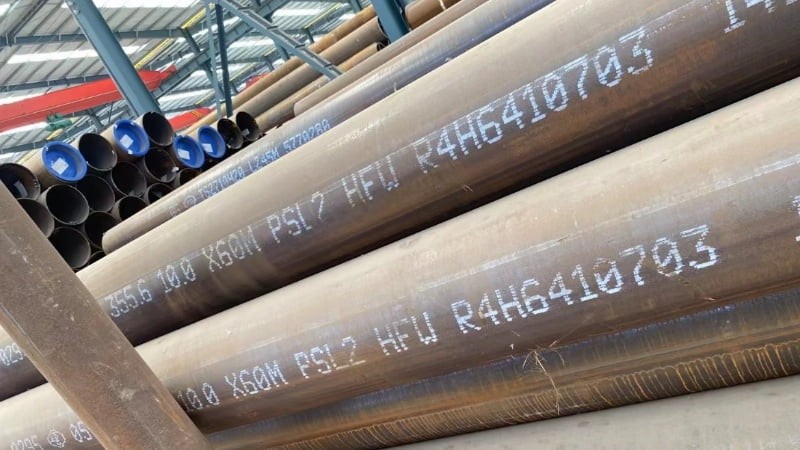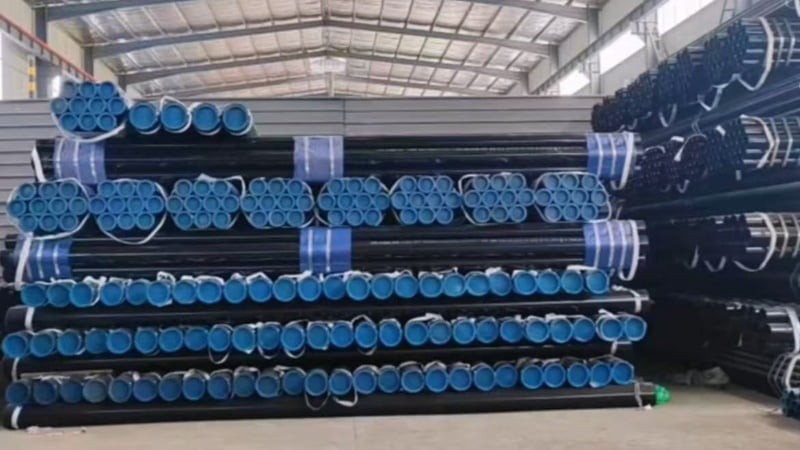Our ERW pipes are manufactured through high-frequency electric resistance welding and precise forming, ensuring uniform weld seams, accurate dimensions, and excellent mechanical performance. As a professional manufacturer, we provide a full-size range from 1/2" to 24", customized OD, wall thickness, and lengths, with strict weld inspection, hydrostatic testing, mechanical testing, and surface control. Our ERW pipes are widely used in fire protection systems, water/oil/gas transportation.
The Electric Resistance Welded Pipe, or ERW pipe, refers to pipes that are made using high-frequency resistance heat welding, which utilizes heat and pressure to join the edges of steel strips.
The ERW pipe is a type of welded steel pipe made from a coil of steel strip. It is manufactured through a process called cold roll forming, followed by high-frequency electric resistance welding, which melts and joins the edges of the steel strip together. The welding line is located along the longitudinal of the pipe body, also known as a straight seam resistance welded steel pipe.

The size table is the standard size produced by our factory. The length, diameter, wall thickness, and weight can all be produced according to the customized requirements.
| Nominal Size | OD (mm) | Common WT (mm) | Weight (kg/m) |
|---|---|---|---|
| 1/2" | 21.3 | 2.0–3.0 | 1.28–1.90 |
| 3/4" | 26.7 | 2.0–3.2 | 1.68–2.54 |
| 1" | 33.4 | 2.3–3.4 | 2.39–3.60 |
| 1-1/4" | 42.2 | 2.3–4.0 | 3.10–5.12 |
| 1-1/2" | 48.3 | 2.5–4.0 | 3.71–5.88 |
| 2" | 60.3 | 2.5–4.5 | 4.70–8.36 |
| 2-1/2" | 73.0 | 2.5–6.0 | 5.72–13.03 |
| 3" | 88.9 | 3.0–6.0 | 6.64–15.10 |
| 3-1/2" | 101.6 | 3.0–6.3 | 7.64–18.44 |
| 4" | 114.3 | 3.2–6.3 | 8.55–20.39 |
| 5" | 141.3 | 3.5–8.0 | 10.47–27.94 |
| 6" | 168.3 | 4.0–10.0 | 15.00–45.50 |
| 8" | 219.1 | 5.0–12.0 | 21.28–61.72 |
| 10" | 273.0 | 5.0–12.0 | 26.70–78.81 |
| 12" | 323.9 | 6.0–15.0 | 38.27–113.00 |
| 14" | 355.6 | 6.0–16.0 | 42.10–130.40 |
| 16" | 406.4 | 6.0–16.0 | 48.40–148.70 |
| 18" | 457.2 | 6.0–18.0 | 54.70–186.80 |
| 20" | 508.0 | 6.0–20.0 | 61.00–224.90 |
| 24" | 610.0 | 6.0–20.0 | 73.20–273.20 |



High-frequency welding produces a dense metal structure with uniform weld seams and high strength in ERW pipe.
ERW pipes have high dimensional accuracy due to continuous cold-bend forming, and outside diameter and schedule are precisely controlled.
The smooth surface and small inner weld bead of ERW welded pipe make it convenient for galvanization, coating, or further deep processing.
Our factory produces ERW pipes efficiently and at a lower cost, making them suitable for mass industrial demand.
ERW pipe (especially ASTM A795/A53) is a standard pipe in the North American fire protection systems.
High-strength weld line, precise sizes ensure sealing and pressure resistance for the fire sprinkler system.
ERW welded pipe, which can be coated with red paint, epoxy, and galvanization on the surface to meet fire protection requirements.
Note: Nearly all UL/FM-certified fire sprinkler pipes are ERW-welded pipes.
The weld seam structure in ERW steel pipes is dense for transporting medium to low-pressure liquids and gases.
High precision outside diameter and wall thickness for the connection of long-distance piping systems.
The ERW steel pipe is widely used in liquid transportation and city gas networks under API 5L standards.
The ERW steel pipe has a small size tolerance and stable molding for welding and connections of structural components.
Stable strength and lower cost of ERW steel pipe make it the first choice in building steel structures, supports, and scaffolding.
The mechanical and automobile industries require high-precision dimensions. ERW steel pipe is welded after cold roll forming and has the highest precision.
The ERW steel pipe features a smooth surface and a weld seam, making it ideal for welding processes, drilling holes, and bending.
ERW pipe can be manufactured into precision automobile parts.
Detection of ERW pipes includes six essential sections: weld seam, dimensions, materials, pressure, mechanical properties, and surface quality.
The following contents are fully equivalent to international standards: ASTM A53, A795, A135, API 5L, and ASTM A500.
Weld seam inspection is the most strict part; the key quality is the weld seam of ERW pipes.
ERW production lines typically incorporate inline eddy current testing equipment for real-time weld monitoring. Capable of detecting: cracks, incomplete fusion, porosity, and slag inclusions.
Nearly all export-grade ERW pipes require 100% eddy current testing.
Ultrasonic Testing is used to detect internal weld defects and fusion imperfections. Common for API-grade and fire-rated products, it can detect deep-seated defects.
Visual Inspection primarily checks whether welds are straight, weld width is uniform, external weld beads are neat, and whether there are burn-throughs, undercuts, or weld spatter.
Hydrostatic Test (ASTM/API Mandatory) involves pressurizing each steel ERW pipe or batch with water to detect leaks. Pressure holding time: typically 5–10 seconds. Pressure value: as specified by standards (e.g., A53 ERW pipe approximately 700–3000 psi). Ensures ERW pipes can withstand working pressure; mandatory for fire protection pipes, structural pipes, and water conveyance pipes.
Used to determine whether material strength meets requirements.
Tensile Test measurements: Yield Strength, Tensile Strength, and elongation. Common standards: ASTM A53, A500, API 5L.
Flattening Test: Compresses steel ERW pipe to a flat state to detect cracks. Evaluates weld fusion quality and material ductility. Applicable to: A53, A795, A135, API 5L.
Bend the steel pipe to the specified radius to check for cracks. Verify the material's toughness and inspect the weld strength.